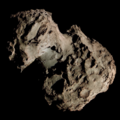 Recovery image of the comet by STEREO on 13 December 2008 | |
| Discovery [1] | |
|---|---|
| Discovered by | Eric J. Christensen |
| Discovery site | Catalina Sky Survey |
| Discovery date | 26 May 2003 |
| Designations | |
| P/2003 K2, P/2008 X4 | |
| Orbital characteristics [2] [3] | |
| Epoch | 21 November 2025 (JD 2461000.5) |
| Observation arc | 22.35 years |
| Number of observations | 947 |
| Aphelion | 5.797 AU |
| Perihelion | 0.524 AU |
| Semi-major axis | 3.161 AU |
| Eccentricity | 0.83408 |
| Orbital period | 5.619 years |
| Inclination | 10.287° |
| 93.797° | |
| Argument of periapsis | 345.95° |
| Mean anomaly | 359.69° |
| Last perihelion | 7 April 2020 |
| Next perihelion | 22 November 2025 |
| TJupiter | 2.492 |
| Earth MOID | 0.170 AU |
| Jupiter MOID | 0.019 AU |
| Physical characteristics [2] | |
| Dimensions | 0.87 km (0.54 mi) [4] |
| Comet total magnitude (M1) | 14.9 |
210P/Christensen is a Jupiter family comet with an orbital period of 5.7 years. It was discovered by Eric J. Christensen on 26 May 2003 in images taken by the Catalina Sky Survey [1] and recovered in images obtained by STEREO, the first time a single-apparition comet was recovered by a spacecraft. [5]




